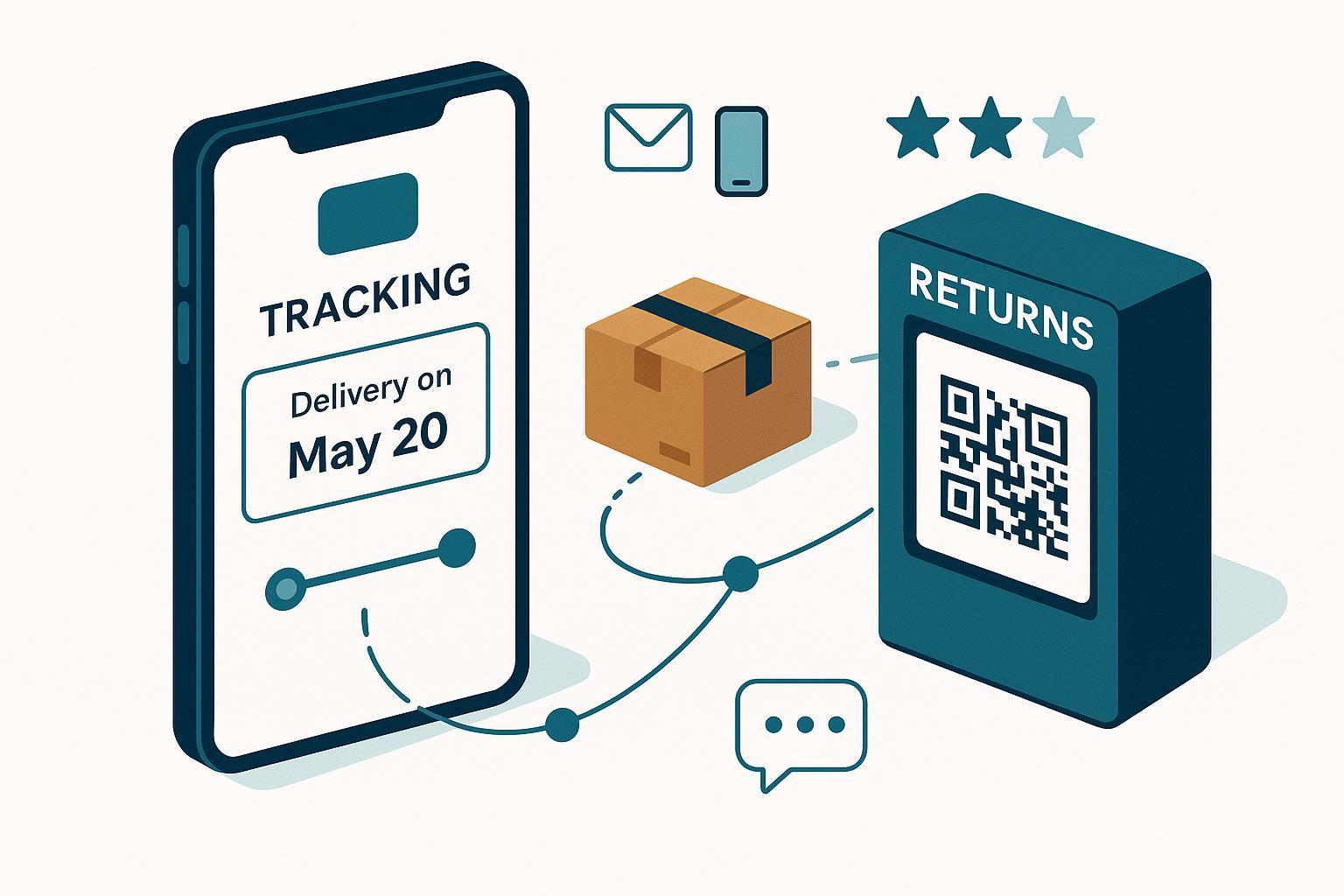Post‑Purchase UX (PPX) Best Practices (2025): A Practitioner Playbook for E‑commerce and SaaS

If you’re still treating “order placed” as the finish line, you’re leaking margin and loyalty. In 2025, customers reward brands that reduce uncertainty after the sale: precise delivery promises, proactive updates, empathetic issue resolution, and effortless returns. Reliability now beats raw speed—consumers increasingly prioritize accurate delivery dates over the fastest shipping, as discussed by the 2024 perspective from Narvar on reliable delivery dates. This guide distills what has worked across multiple PPX deployments I’ve led, the pitfalls I’ve seen, and how to measure impact.
—
Quick map: the post‑purchase journey (digital + physical)
- Confirmation: Order summary, delivery promise, clear next steps
- Tracking: Branded hub, proactive notifications, self-service help
- Delivery: Accurate ETA updates, issue handling, protection
- Ownership: Setup/care content, reviews/UGC, replenishment/cross‑sell
- Returns/Exchanges: Frictionless, revenue‑retentive, transparent policies
- Support: Context‑rich assistance across channels
- Loyalty: Re‑engagement, benefits, community
Tip: Treat this as a product surface, not a set of emails.
—
- Order confirmation that sets expectations (and avoids new friction)
Why it matters
- This is where you reduce anxiety: “Did it go through? When will it arrive? What if I need help?”
- Poorly timed prompts (e.g., forcing account creation mid‑checkout) increase abandonment and erode trust. Baymard’s 2025 guidance found many sites still interrupt too early; deferring account creation until the confirmation page preserves checkout focus and increases acceptance, per the Baymard Institute 2025 post‑checkout UX findings.
Baseline best practice
- Confirmation page with plain‑English summary, delivery promise date/window, next steps (e.g., “You’ll get SMS updates”), and one‑click access to order status.
- Email confirmation sent within seconds; SMS only with explicit opt‑in.
Advanced play
- Offer post‑purchase account creation on the confirmation page with a single tap (prefilled email from order). Explain benefits succinctly (tracking, faster returns).
- Show live, ML‑driven estimated delivery dates (EDD) that account for weekends/holidays and local cutoffs, aligning later updates to the same promise. Retailers using AI‑powered EDD models report 95%+ accuracy with solutions like those described in the Narvar Promise overview.
Pitfalls and trade‑offs
- Over‑selling “fast shipping” sets yourself up for disappointment; promise what you can keep.
- Don’t bury support. Prominent “Need help?” links reduce panic‑driven tickets.
Implementation checklist
- Confirmation page delivered in <1s and cached for return visits.
- Order summary includes item images, costs, taxes, shipping method, delivery promise.
- Add calendar add‑to (optional) with expected delivery window.
—
- Delivery promises and proactive notifications that actually calm customers
Why it matters
- Uncertainty drives “Where is my order?” (WISMO) contacts. Accuracy and transparency reduce support load and improve CSAT. The shift from speed to reliability is documented in 2024 by Narvar’s analysis of delivery date preferences.
Baseline best practice
- Present a specific delivery date (or tight window) at checkout and carry it through confirmation, emails, and tracking. Avoid vague “5–7 business days.”
- Trigger notifications at key milestones: confirmed, shipped (with tracking), out for delivery, delivered.
Advanced play
- Predictive EDDs that adjust in real time for carrier performance, weather, and regional cutoffs, using ML as described in the Narvar Promise approach.
- Dynamic channel mix: default to email for low‑urgency updates; escalate to SMS/push for delays/attempted deliveries.
- “No surprises” policy: proactively notify of delays and offer options (reschedule, local pickup) when possible, following orchestration best practices discussed by Delivery Solutions on post‑purchase control.
Pitfalls and trade‑offs
- Over‑notifying creates fatigue; limit to meaningful state changes.
- If you promise a date, own it—explain deviations, don’t hide.
Implementation checklist
- Centralized event model for order/shipment states across all channels.
- Quiet hours and locale‑sensitive templates; link to live status hub.
—
- Branded tracking hubs that drive engagement (and revenue)
Why it matters
- Sending customers to carrier pages is a missed opportunity. Branded tracking hubs increase trust, centralize support, and can drive incremental sales when done thoughtfully. Case examples cataloged by AfterShip show branded tracking pages generating meaningful engagement and repeat sales, including a reported 30% lift in repeat sales for Vivino and a 6.5% CTR on recommendations on certain tracking pages, per the 2024–2025 guidance in the AfterShip branded tracking best practices and case notes and the AfterShip case library (Wineshipping).
Baseline best practice
- Host tracking on your domain with order details, EDD, and carrier events. Include help links and a simple “report an issue” flow.
Advanced play
- Personalize the tracking hub with relevant content: setup/care guides, order‑specific recommendations, and community posts. AfterShip’s public write‑ups cite tracking page engagement such as 45% of visits originating from tracking for some brands and sales attribution from that surface, per the same AfterShip best practices and cases.
- Integrate self‑service outcomes: “Delivery problem?” → instant credit/reship where policy allows.
Pitfalls and trade‑offs
- Don’t turn tracking into an ad wall. Prioritize utility, then gently layer commerce.
- Keep ETA consistent with what was promised at checkout.
Implementation checklist
- Fast page (<1.5s LCP), mobile‑first, authentication‑light.
- Inline status explanations (“What does ‘in transit’ mean?”) to reduce contacts.
—
- Delivery issues: make resolution instant when possible
Why it matters
- Delays, damage, and theft erode trust. Smooth claim and resolution flows save the relationship. With rising package‑theft anxiety in the U.S., programs that provide shipping protection and streamlined claims can reduce friction and maintain loyalty; see the 2024–2025 framing in the Narvar Secure overview.
Baseline best practice
- Prominent “Report a problem” CTA on tracking and order pages; capture photos for damage; clear SLAs.
Advanced play
- Automate outcomes: low‑value claims → instant credit; high‑value → fast triage. Offer shipping protection opt‑in at checkout; approved claims trigger automatic reship.
- Address intelligence and rescheduling options to prevent failures, as highlighted by Delivery Solutions on orchestration and flexible delivery.
Pitfalls and trade‑offs
- Over‑generous automation can invite abuse; add fraud signals and limits.
- Protection fees can depress conversion; test price points and explain coverage transparently.
Implementation checklist
- Unified incident taxonomy (delay, damage, lost, porch theft) and routing rules.
- Clear thresholds for auto vs. manual handling.
—
- Returns and exchanges that protect revenue without eroding trust
Why it matters
- Returns are inevitable. The goal is to retain as much revenue and goodwill as possible while controlling costs. Merchants increasingly use intelligent fees, exchanges‑first flows, and returnless refunds for low‑value items to strike the balance, according to 2024–2025 insights from Loop Returns on intelligent fees and returnless refunds, and by Shopify’s guidance on returnless refunds.
Baseline best practice
- Clear policy page with plain language, timelines, and conditions. Provide a self‑service portal to initiate returns with label/QR code generation.
Advanced play
- Exchanges‑first UX: pre‑populate alternative sizes/colors; incentivize store credit with small perks. Automate approval rules; allow boxless drop‑offs where networked.
- For sustainability, use right‑sized packaging and provide recycling guidance; weigh costs and environmental impact carefully. McKinsey’s 2023 analysis notes reusable packaging can cost 50–200% more unless reused enough cycles, highlighting the need for pragmatic pilots, per the McKinsey reusable packaging impact study (2023).
Pitfalls and trade‑offs
- Blanket free returns encourage abuse; overly punitive fees drive churn. Test bands (by item value/category/region) and communicate rationale.
- “Green” initiatives that increase cost/complexity without net benefit will backfire; publish your logic.
Implementation checklist
- Returns flows embedded in order hub; instant status updates and refund timing transparency.
- Conditional logic: auto‑approve low‑risk, flag edge cases, and deter serial abuse.
—
- Post‑purchase emails/SMS that drive ownership and repeat purchase
Why it matters
- Automated, behavior‑triggered flows consistently outperform batch campaigns. Benchmarks from 2025 show strong performance for post‑purchase automations: open rates, click‑through, and placed‑order rates that exceed generic blasts. See the 2025 Klaviyo email benchmarks and their automation examples for typical ranges and flows.
Baseline best practice
- Sequence: order confirmed → shipped → delivered → review request (timed) → care/setup content → replenishment (if applicable).
- Authenticate and protect deliverability (SPF, DKIM, DMARC); segment by engagement to maintain inbox placement as reinforced in the 2025 Omnisend deliverability guidance.
Advanced play
- Personalize timing to delivery date + usage curve (e.g., send care guide 24 hours after delivery; review request at 5–7 days post‑delivery). PowerReviews’ 2023 guidance supports multi‑prompt cadences and photo incentives to lift review volume and quality, per the PowerReviews complete guide (2023).
- Use post‑purchase browsing and product telemetry (for SaaS) to trigger expansion content and human outreach.
Pitfalls and trade‑offs
- Over‑solicitation increases unsubscribes and spam flags. Cap reminders and stop when the action is completed.
- One‑size‑fits‑all incentives can train discount dependence; target selectively.
Implementation checklist
- Link every message to the live tracking/order hub.
- Maintain two prompts max for reviews; suppress once submitted.
—
- Reviews and UGC that compound trust
Why it matters
- Social proof increases conversion and feeds discovery (ads, SEO). Timely, relevant asks perform best. Practical playbooks from 2023–2025 emphasize timing review requests 5–7 days after delivery, using multi‑prompt sequences, and incentivizing photos to increase impact; see PowerReviews’ 2023 guide and Yotpo’s post‑purchase request best practices.
Baseline best practice
- Collect rating + text review with a short, mobile‑friendly form. Publish transparently (including critical feedback).
Advanced play
- Ask for photo/video UGC on eligible items; route high‑value reviews to PDP and lifecycle content. Syndicate to ad platforms where supported.
- Close the loop: respond to negative reviews quickly and show remediation.
Pitfalls and trade‑offs
- Over‑incentivizing can bias content; disclose incentives where required.
- Don’t send review asks before delivery confirmation.
Implementation checklist
- Two‑step request: short initial ask, optional detail follow‑up.
- Highlight UGC in the tracking hub during the ownership phase.
—
- Support and omnichannel context that feels human
Why it matters
- When customers escalate, they expect you to remember the entire context—order details, previous contacts, and current status. Research aggregations indicate the expectation of context continuity is now mainstream; see the 2024–2025 Zendesk customer experience statistics hub.
Baseline best practice
- Unify order data with your helpdesk. Surface order status, returns, and prior messages to agents.
Advanced play
- Provide a single post‑purchase hub (web/app) that consolidates tracking, issues, returns, and support. Offer callbacks or chat with context sync.
- Use intent models to triage: delays → proactive empathy scripts; damage → instant credit eligibility.
Pitfalls and trade‑offs
- Fragmented systems create contradictory answers; invest in orchestration before adding more channels.
Implementation checklist
- Channel hygiene: consistent templates and SLAs across email/SMS/chat/phone.
- Post‑contact CSAT on issue resolution, not just after delivery.
—
- SaaS parallels: onboarding is your post‑purchase
Why it matters
- For SaaS, “delivery” is activation. Time‑to‑value and early success moments determine retention and expansion. Benchmarks indicate activation rates vary widely by product but are often well below 50%, with recent reports highlighting averages and drivers; see the 2024 Userpilot activation benchmark report and onboarding practices from Pendo’s guidance for startups.
Baseline best practice
- Onboarding checklists, contextual tooltips, getting‑started emails, and an in‑app resource center.
Advanced play
- Behavioral segmentation for CSM outreach; in‑product nudges tied to activation milestones; progressive disclosure to prevent overload.
Pitfalls and trade‑offs
- Over‑gamifying onboarding can distract from core value. Keep steps tied to real outcomes.
Implementation checklist
- Define activation events clearly; measure time‑to‑value and first‑week retention.
—
Measurement and KPIs that prove PPX ROI
Track a core set that ladders to cost, loyalty, and revenue:
- Delivery promise accuracy (EDD vs. actual), first‑attempt delivery success
- WISMO contact rate; support tickets per 1,000 orders; deflection rate
- Tracking hub engagement: repeat visits, CTR on help/education/recommendations (AfterShip case notes show CTRs in the mid‑single digits on rec modules; see the 2024–2025 AfterShip best practices)
- Returns mix: exchanges‑to‑refunds ratio; refund latency
- Post‑purchase revenue: placed‑order rate and revenue per recipient from automations (reference 2025 Klaviyo benchmarks)
- Review/UGC volume and response time; CSAT/NPS after issue resolution
- Repeat purchase rate at 30/60/90 days (for SaaS: activation, Day‑7/30 retention)
Reporting cadence: weekly for ops metrics (EDD accuracy, WISMO), monthly for revenue outcomes (repeat rate, automation RPR).
—
Neutral tooling landscape (fit by need)
- Post‑purchase orchestration: platforms that provide branded tracking, notifications, returns, and protection are common choices. Public materials from 2024–2025 show capabilities like AI EDD, branded hubs, and automated claims; see overviews from Narvar and AfterShip.
- Delivery orchestration/address intelligence: unify delivery options and enable rescheduling; a 2025 perspective is provided by Delivery Solutions on control and orchestration.
- Returns platforms: exchanges‑first workflows and automation from providers like Loop Returns and boxless networks such as Happy Returns.
- ESP/SMS: lifecycle automation and benchmarks from Klaviyo; deliverability guidance via Omnisend’s 2025 primer and supplemental benchmarks from Mailchimp’s resources.
- Support/CRM: ensure order data context in systems like Zendesk.
Selection tip: Optimize for native integrations with your ecommerce platform, carrier stack, and helpdesk to avoid brittle custom glue.
—
Mini‑scenarios: what actually changed outcomes
Scenario A — Branded tracking + predictive EDD
- Problem: High WISMO; customers bouncing between carrier pages and support.
- Action: Deployed on‑domain tracking hub with ML‑backed EDD and SMS for exceptions only.
- Result: Tracking CTR on recommendation modules in the 5–7% range (consistent with examples seen in the AfterShip best practices and cases); support workload declined as customers self‑served status in one place.
- Lesson: Centralizing truth + accurate promises reduces anxiety and tickets.
Scenario B — Exchanges‑first returns with intelligent fees
- Problem: High refund leakage; free returns abused on low‑value items.
- Action: Introduced exchanges‑first flow, small credit incentive, conditional fees, and returnless refunds for items under a set threshold.
- Result: Refunds decreased; exchange rate increased while CSAT stayed stable, consistent with 2024–2025 practices outlined by Loop Returns.
- Lesson: Fees and automation work when paired with attractive exchange options and clear communication.
Scenario C — Post‑purchase automations tuned to ownership moments
- Problem: One‑size post‑purchase emails underperformed.
- Action: Implemented staggered content by product: setup guide 24h post‑delivery, review ask at Day 5–7, replenishment at predicted usage window.
- Result: Placed‑order and revenue‑per‑recipient climbed in line with 2025 Klaviyo benchmark ranges.
- Lesson: Timing and relevance beat volume; let delivery and usage drive comms.
—
Common pitfalls to avoid
- Over‑automation without empathy: Delays need human tone and clear options.
- Inconsistent EDDs across channels: One promise, one source of truth.
- “Ad first” tracking pages: Utility must come before merchandising.
- Punitive returns without alternatives: Provide exchanges and credits.
- Ignoring deliverability: Auth, segmentation, and list hygiene aren’t optional in 2025; see Omnisend’s deliverability primer.
—
What’s next (2025–2026): prepare now
- Predictive PPX mainstreaming: inventory‑aware ETAs and dynamic rerouting.
- Address intelligence at checkout: fewer failed deliveries, lower cost, better experience; see orchestration trends via Delivery Solutions’ 2025 perspective.
- Sustainable returns: boxless drop‑offs, repair/resale channels; balance costs per the McKinsey 2023 reusable packaging analysis.
- Integrated community: UGC and owner tips baked into tracking and order hubs, with evidence‑based cadences from PowerReviews (2023) and Yotpo guides.
- Insurance/protection normalized for mid/high AOV categories, with clearer UX at checkout as framed by the Narvar Secure overview.
—
Quick start checklist (use this to prioritize)
- Show accurate EDD at checkout and carry it through every surface.
- Replace carrier links with a fast, branded tracking hub.
- Send only meaningful notifications; escalate delays empathetically.
- Make returns self‑service, exchanges‑first; pilot returnless refunds on low‑value items.
- Time review requests to delivery + 5–7 days; cap reminders at two.
- Align support tools so agents see full order context.
- For SaaS, define activation and measure time‑to‑value; nudge to the “aha.”
If you implement only three things: accurate promises, a useful tracking hub, and an exchanges‑first return flow. In my experience, those three moves deliver the fastest, most defensible PPX ROI.

